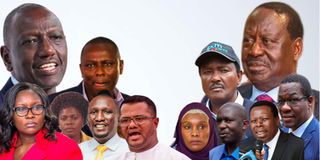Boundary review next battlefront for Ruto, Raila in inter-party talks

President William Ruto (top left) and his Kenya Kwanza talks team and Azimio leader Raila Odinga (top right) and his team.
President William Ruto and Azimio la Umoja One Kenya Coalition Party leader Raila Odinga are on a collision course over boundary review, one of the sticking points for the National Dialogue Committee.
Mr Odinga wants the boundary issue to be considered by the team, whose technical panel has been given until Friday to harmonise the agenda before talks between Azimio and Dr Ruto’s Kenya Kwanza Alliance can formally begin.
The talks could have far-reaching political ramifications, opening the door to constitutional reforms. The Constitution provides for a periodic review of the names and boundaries of constituencies at intervals of not less than eight years and not more than 12 years.
With the last review having happened in March 2012, the Independent Electoral and Boundaries Commission (IEBC) is expected to have ensured that the validation of constituency boundaries is on track to meet the March 2024 deadline.
There are indications that the number of constituencies, currently capped at 290 by the Constitution, is likely to be affected as population growth has increased the quota to 164,015 from the 133,000 that informed the 290 constituencies in 2010.
The population quota is the figure obtained by dividing Kenya's 2019 population of 47,564,296 by the number of constituencies.
Given this, there can never be a change in the number of constituencies from 290 without amending the Constitution.
"That is why one of the imports of these talks is to have a cordial working relationship that will lead us to a compromise reform journey that does not see the government and the Opposition pulling on opposite sides. However, it may not be a walk in the park, especially on the issue of boundary delimitation,” a highly placed source in the deliberations confided to Nation.
The boundary review is political in nature because it defines the geographical areas for leaders and their subjects, as well as access and distribution of economic benefits. It also, in some areas, defines the identity of a people because of their historical attachment to certain geographical features.
With the 2027 elections looming, Kenya Kwanza and Azimio, the largest coalitions, are keen to benefit from the boundary review and neither side is prepared to lose out in the talks.
The review is key to the presidential election in determining the percentages required by law.
For example, Article 138(4) states that a candidate shall be declared President-elect if he or she receives more than half of all the votes cast in the election and at least 25 per cent of the votes cast in each of more than half of the counties.
Both Dr Ruto and Mr Odinga will be keen to ensure that their support bases in the 47 counties are not affected by the possible shifting of wards along county boundaries, which could affect their vote totals and percentages. The delimitation is also crucial because it will lead to an increase in the number of constituencies and wards, which will mean additional resources in terms of constituency and ward development funds.
The two leaders will be looking at how much they can gain from the increased number of representatives with the aim of maintaining a majority in the two Houses of Parliament and County Assemblies.
In addition, the biggest headache for the IEBC, which is also to be reconstituted through a bipartisan approach between Kenya Kwanza and Azimio, will be how to deal with the 26 protected constituencies that failed to meet the population quota in the first review in 2012.
The Constitution specifically provides for 290 constituencies, and if the IEBC were to merge any of the 26 that still do not meet the population quota, it would have to create a new constituency, most likely in a different location or region.





